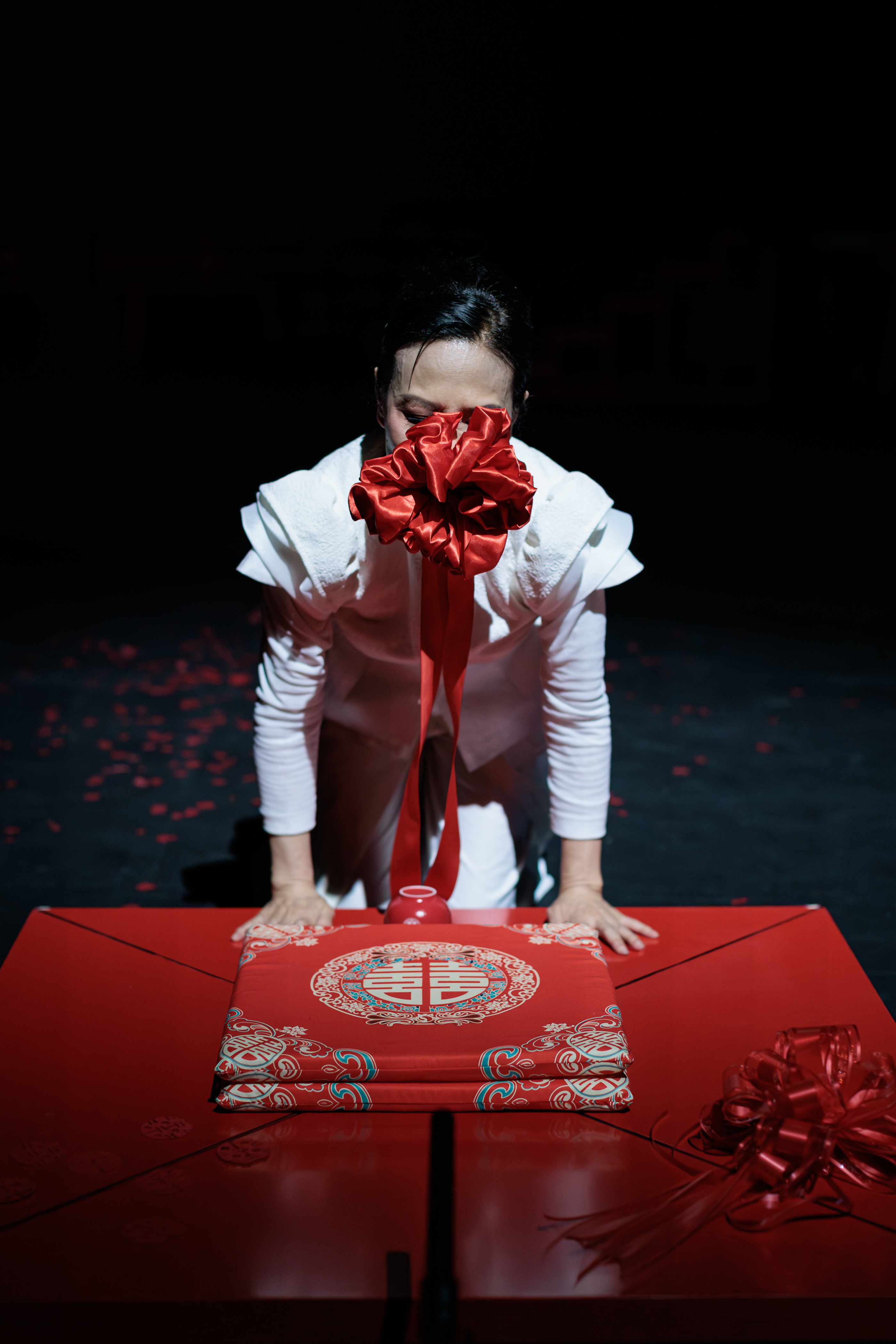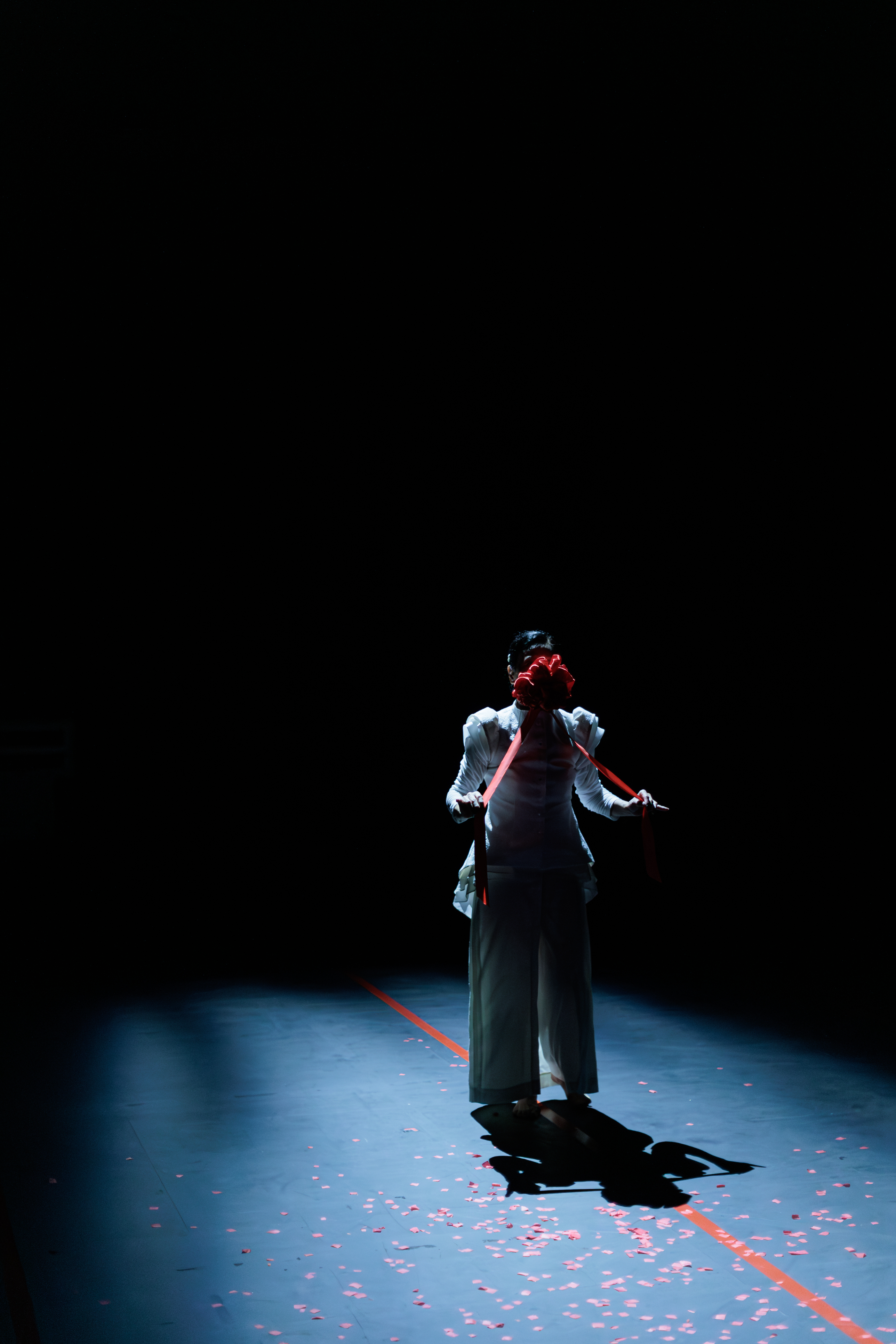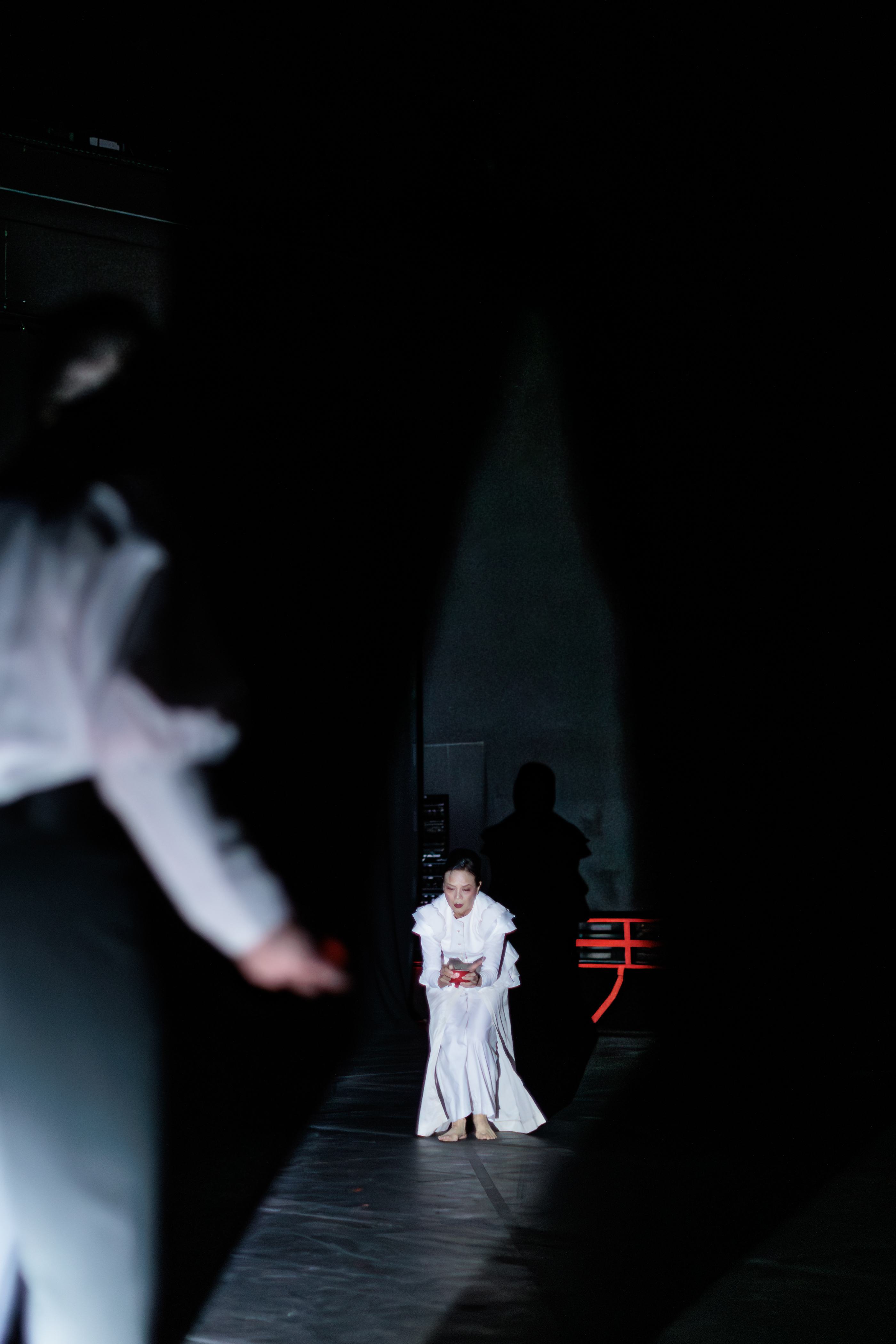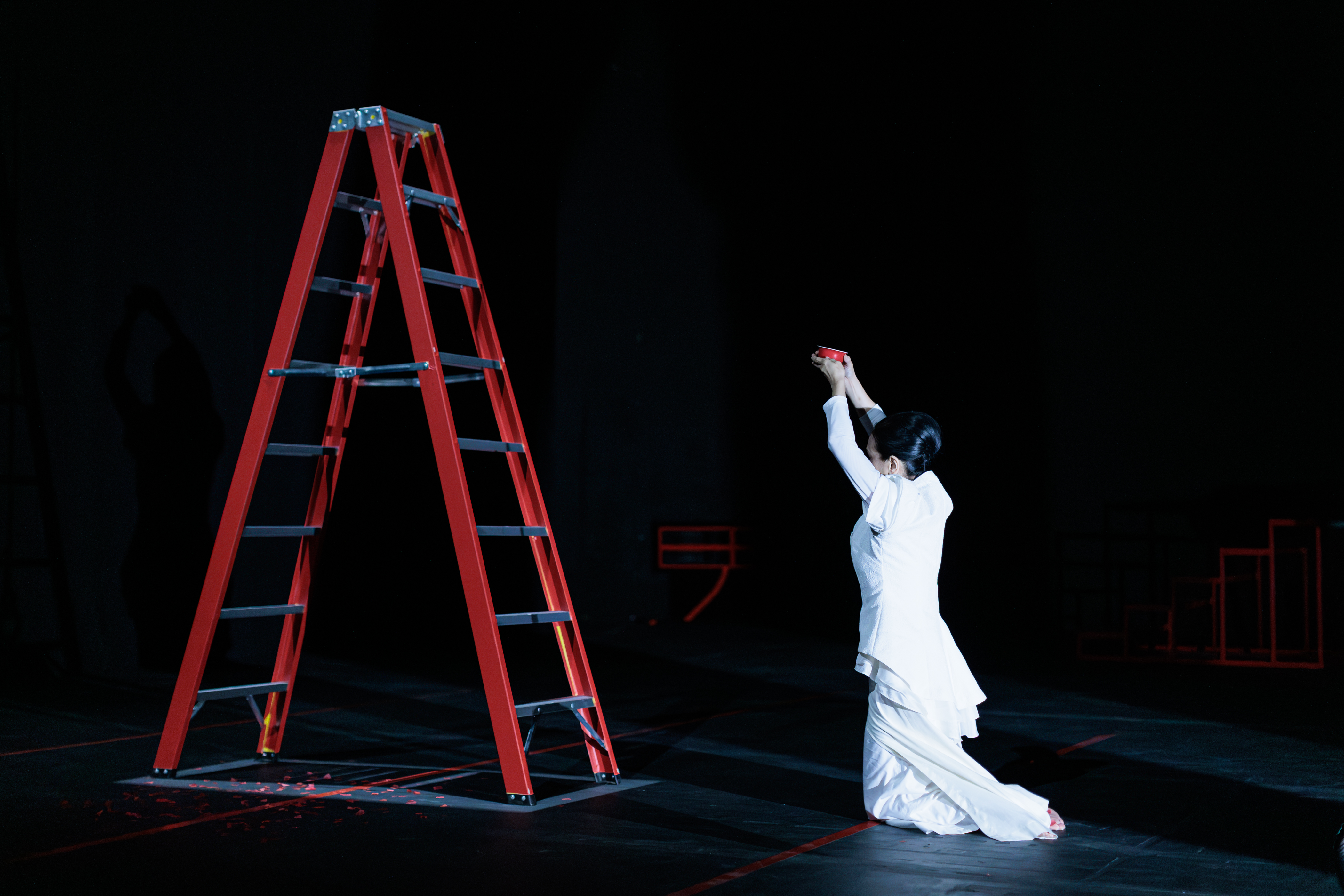I went great lengths to see Mui Cheuk-yin’s work, Double Happiness: The Promise of Red (“Double Happiness” as follows) as part of the “Freespace Dance 2023" programme, because I think every chance to see Mui’s performance nowadays is a rare one, especially it is the kind of solo dance that integrates with life experience. I have seen many works in Mui’s Diary series, thus I have the feeling to have already followed great lengths of Mui’s life, and have developed a particular understanding of how difficult everything has been for her. What’s intriguing about Mui’s work is her complexity: she is both rational and emotional while also incredibly intuitive in weaving together rich layers of cultural meanings; she conceives of a kind of playfulness that is complex, exquisite yet spontaneous. Her previous work Diary VII • The Story Of...... at Tai Kwun moved me deeply – it was a visceral and poignant work. In a slightly different tone and theme, Double Happiness presents deep reflections on culture and its variations. Although Double Happiness gives a completely different impression on the viewer, I am glad that I did not miss this latest performance, as with all the previous ones.
The fundamental thought of Double Happiness is to turn the jovial tone of marriage on its head as a counterclaim: happiness is transformed into sadness, while auspiciousness becomes the prelude to omen.
Photo:Eric Hong @Moon 9 Image
Transforming happiness into sadness, in search of modern subjectivity
The concept of Double Happiness derives from reflections on marriage, which Mui describes in three layers. The first involves traditional Guangdong wedding rituals: Mui transforms customs including the betrothal, hair combing, leave-taking, tea and bed setting ceremonies into dance interpretations, which form the skeleton of Double Happiness. The second includes Hong Kong walled village women’s singing of bridal laments in the 1960s, followed by The Flower Princess – a classic life and political Chinese opera centred around a suicidal death wedding as an act of honour and defiance. From this perspective, the fundamental thought of Double Happiness is to turn the jovial tone of marriage on its head as a counterclaim: happiness is transformed into sadness, while auspiciousness becomes the prelude to omen; Mui searches for the shadows of anxiety and sorrow behind red and celebratory rituals. This reversal is a classic modern gesture: through the search of the darkness and agony in traditions comes the exploration of the birth of the modern subject.
Spotlights shine at the Guangdong wedding items displayed at the front of the stage, rendering them bright and dazzling, while other parts of the stage remain dark for most of the duration of the performance. A red cloth over 10 metres long hangs from the centre of the stage, and suddenly changes into black or indigo under certain lighting, transforming moments of happiness into sadness. Eileen Chang once said, “Even if people can wait, times are hasty and in destruction, and even greater destruction is coming. One day, our civilization, whether it be sublimation or extravagance, will become the past” (introduction of the second edition of Romance). The performance echoes what Chang describes as the “threat of desolate”: as Mui meanders, carries and is enveloped by the wedding red umbrella she holds, sounds that resemble the screeching of the drumhead are mixed with Chinese celebratory music. What I first suspected to be equipment errors turn out to be meticulous music arrangements by Steve Hui; the increasing frequency of these sounds demonstrates the hidden turbulence underneath the facade of joviality.
A large amount of Chinese-style symbolic props embodies “celebration”.
Photo:Eric Hong @Moon 9 Image
A large amount of Chinese-style symbolic props embodies “celebration”, and Mui also demonstrates her background in Chinese dance in various sections such as the departure of the bride from her home. In no part of the performance does she exhibit a sense of happiness as she naturally integrates traditional Chinese dancing styles into rituals, her moves are always uncertain, hesitant, exploratory and struggling. The performance of the wedding chaperone (dai kum) Chan Kin-man left a deep impression on many: unlike Mui, he always wears a dai-kum-style motivating smile on his face, accompanied with a loud and clear voice, as well as lively body movements to perform the comedic parts of the performance –– the parts in opposite of Mui. What’s worth noticing is that Chan plays the part of the male wedding chaperone and not the groom, hence what Mui wants to examine is the antinomy between individuals and rituals or systems, rather than that between individuals.
An obedient death versus an autonomous death
Wedding rituals are overwhelmingly filled with symbols of happiness and auspiciousness, thus the inclusion of the deep and sorrowful voices of the bridal laments and the libretti of The Flower Princess focus on highlighting the agony of marriage. While “bridal lamenting” articulates the sadness and worries towards the uncertainty of one’s life that comes with arranged marriages with strangers, The Flower Princess directly addresses the topic of death. Is it an overstatement to link marriage with death? It is in fact not. Talks of Chinese women’s lack of autonomy in marriage, and the tradition of married women becoming a part of their husbands’ property are not new. I also found an excerpt of 18th-century English law in American female writer and activist Rebecca Solnit’s book Men Explain Things to Me:
By marriage, the husband and wife are one person in law: that is, the very being or legal existence of the woman is suspended during the marriage, or at least is incorporated and consolidated into that of the husband; under whose wing, protection, and cover, she performs every thing; and is therefore called in our law–French a femme-covert . . . or under the protection and influence of her husband, her baron, or lord; and her condition during her marriage is called her coverture. For this reason, a man cannot grant anything to his wife, or enter into covenant with her: for the grant would be to suppose her separate existence. (Blackstone, 1765)
This passage demonstrates that it was generally believed in England at the time that marriage indicated a woman's life to be owned by her husband – the husband’s existence taking control over that of the wife. Therefore, marriage could be seen as the end of a woman's autonomous life in law; in other words, it is a symbolic death of her autonomy. This is the same in both eastern and western cultures.
Mui shakily holds the teacup above her head as she kneels. Mui’s humble and small figure stands in stark contrast with that of Chan’s, displaying the disparity in their strengths.
Photo:Eric Hong @Moon 9 Image
From this, one can see that the scepticism towards marriage in Double Happiness is to a large extent an antinomy between obedience and autonomy. In the section ‘tea ceremony,’ Chan stands on the fitness vibration platform and says with a shaky and weird voice, “Enjoy wedding tea, it heralds success and wealth.” Chan’s body, especially his legs, appear to be enormous under light projection, while Mui shakily holds the teacup above her head as she kneels. Mui’s humble and small figure stands in stark contrast with that of Chan’s, displaying the disparity in their strengths. Power relations are presented here as one’s choice of obedience: the shadows of the man’s legs exhibit sexual appeal while the repetitively chanted slogan “it heralds success and wealth” showcases the temptation of economic power for those who are in weaker positions. Under the suppression of power and money indeed stands little ground for “autonomy”.
In comparison, the meticulously calculated wedding in The Flower Princess as a political move is fundamentally a kind of biopolitics. Changping and Shixian refuse to be corrupted; if celebration embodies obedience, then death in this case represents autonomy.
Dance amidst anxiety, move forward without burdens
I have always felt that wedding auspicious sayings are full of sexual meanings. Aren’t the extensive wishes for the newlyweds to have children too much a concern over other people’s sex life? The bed setting ceremony requires a “good fortune man” to move the bridal bed to an appropriate location a few days before the wedding on a fortuitous date and time, and then a “good fortune lady” to set and decorate the bed with auspicious fruits and items (such as red beans, a pair of tangerines, dried red dates, lotus seeds, lily bulbs and red packets etc.). After the newlyweds enter the room, children can eat the auspicious fruits on the bed – a symbolic blessing for the couple to have many offspring. Mui chooses a trampoline – the opposite of a “set” bed. As she kneels and moves up and down on the trampoline covered with red silk, the scene is filled with sexual metaphors that reveal what were previously hidden by celebratory items. Mui rises and falls as she grasps the red silk on the bed, as if she is in search of answers in a boundless sea. She eventually attempts to stand and jump yet struggles to stand upright for a long time – the red silk both locks and supports her. In the end, she pushes the red silk out of the trampoline, revealing the trampoline in its bare form – a thing that both uplifts and sucks one in. This section is what I deem to be the most ingenious set-up in Double Happiness.
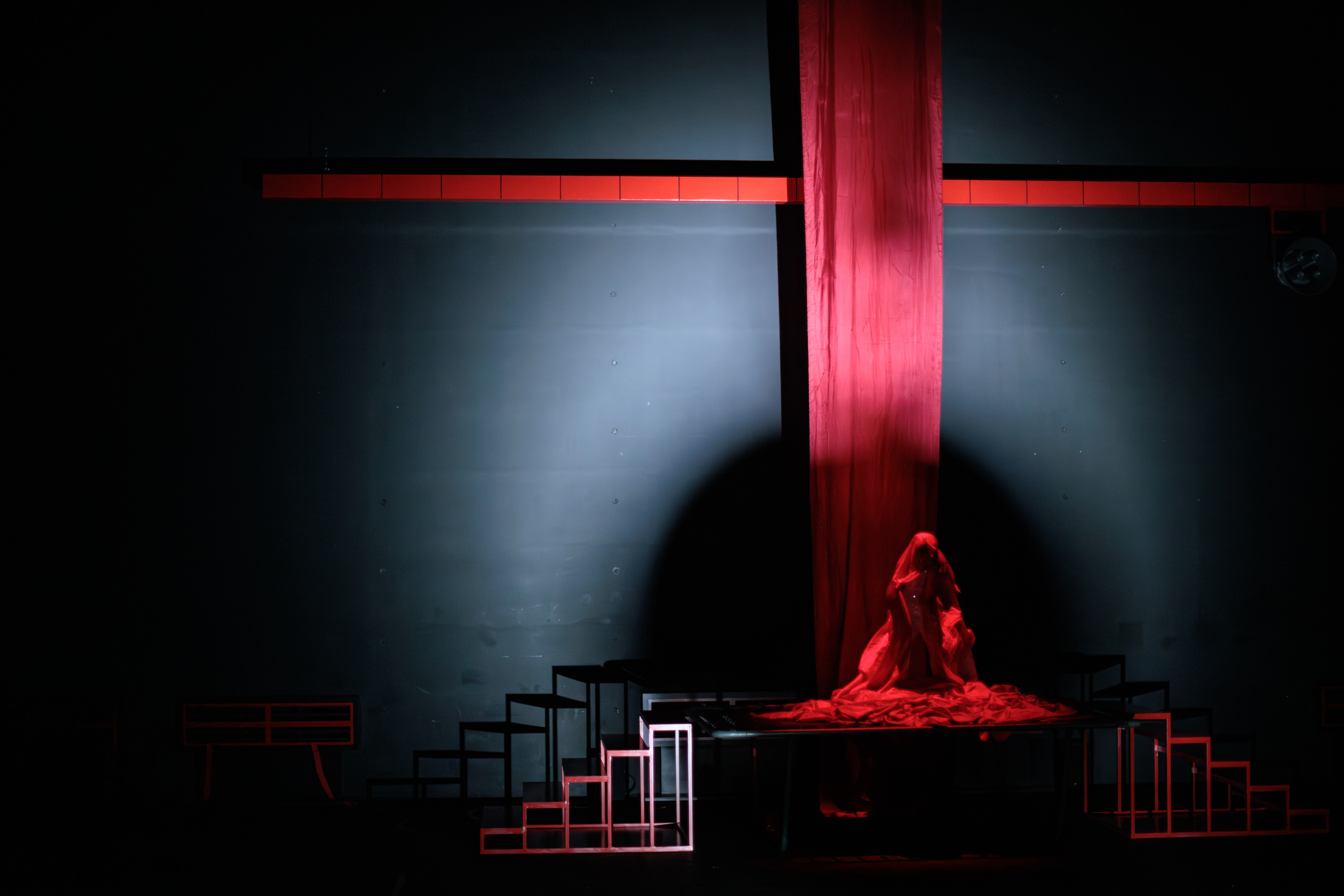
Photo:Eric Hong @Moon 9 Image
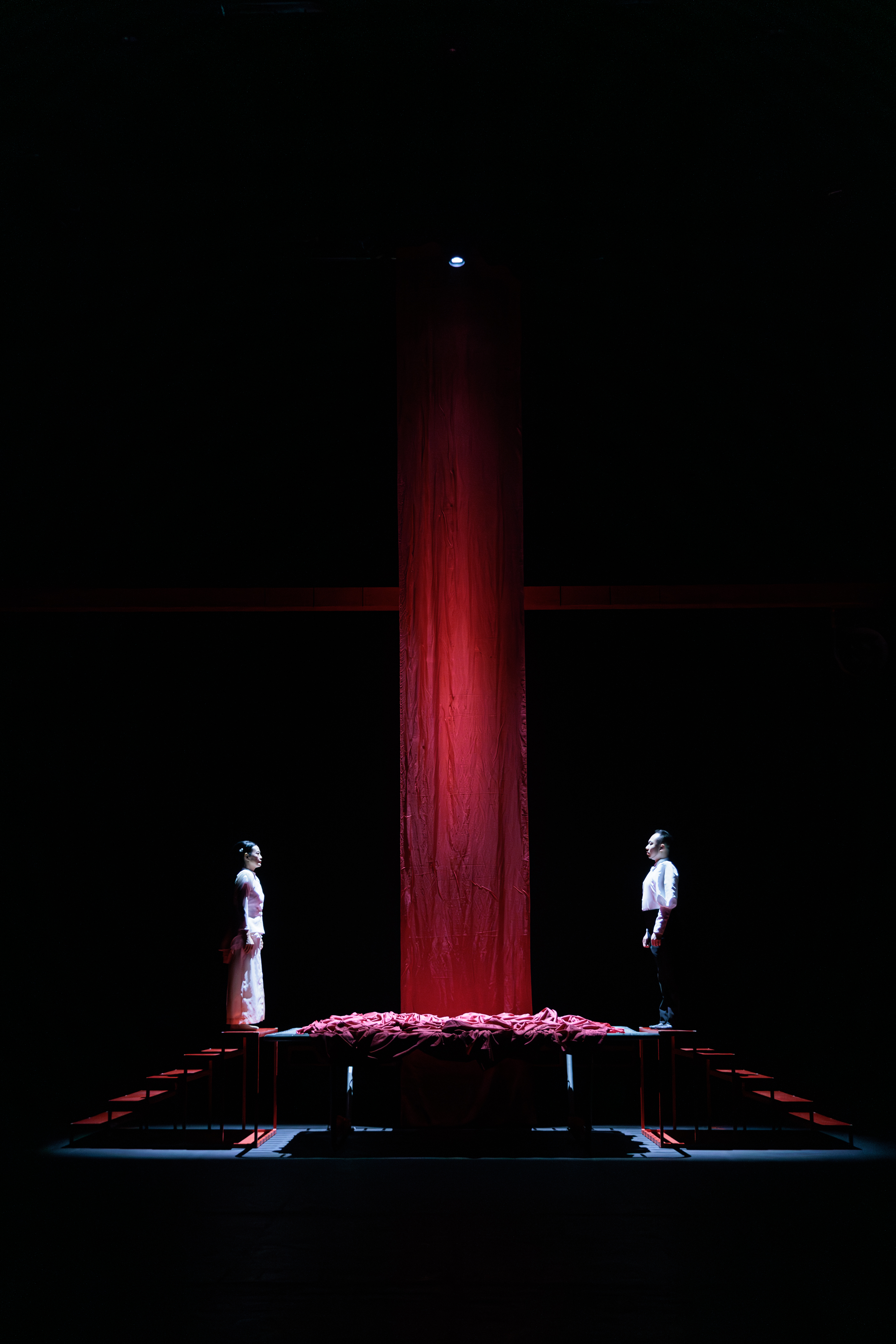
What’s worth noticing is that Chan plays the part of the male wedding chaperone and not the groom, hence what Mui wants to examine is the antinomy between individuals and rituals or systems, rather than that between individuals.
Photo:Eric Hong @Moon 9 Image
Although Double Happiness presents profoundly deep multi-layered cultural reflections, what’s worth noticing is that Mui’s approach is, in contrast, incredibly light – everything seems to be within the reach of her fingertips and are reborn by her hand, and the most ordinary items are given a new life through her performance. The stage design is simple, with nothing hidden from one’s sight. In fact, the set-up is so simple that it resembles a construction site rather than a bridal chamber. The bare structure demonstrates a simplicity that counters the glamorous wedding rituals that are filled with metaphors on power relations. In recent years, Mui’s works are endowed with a sophisticated simplicity that could be seen in the most subtle places – great art in fact conceals itself. While Mui’s work is an enjoyment to herself, she has also through her creations passed on the intangible cultural heritage of bridal laments to the audience. It is also through this work that I learned about the book, A Glimpse through Ming-Wa-Kou: The Bridal Laments of the Last Walled-Village Brides – a truly delicate gem.
Those who are happy live and shine like everlasting fireworks, while those who sorrow seek endlessly for an autonomy that never arrives. How does this dialectic end? In a dance near the end, Mui holds a mask as if she is forcing a smile. Yet that mask is two-faced – the happy face turns to a sad one when she turns it upside down. After a round of twisting and turning, Mui takes off her mask: she looks confused but carries a sense of peacefulness that requires no pretending. Confusion is a state without answers. The question is whether I can preserve the freedom of “not having answers just yet”? In our search of ourselves and our resistance against external forces, what we are ultimately after is no more than the openness that comes with the state of “not having the answers just yet’” – the space given for one to think and decide whether to laugh or not. This is a kind of openness. As to whether wearing a bridal gown and a veil upon standing at the top of the stairs is a form of obedience or refusal: an openness is preserved before the veil is lifted; one can have a more certain answer after one’s own reflection and imagination.


